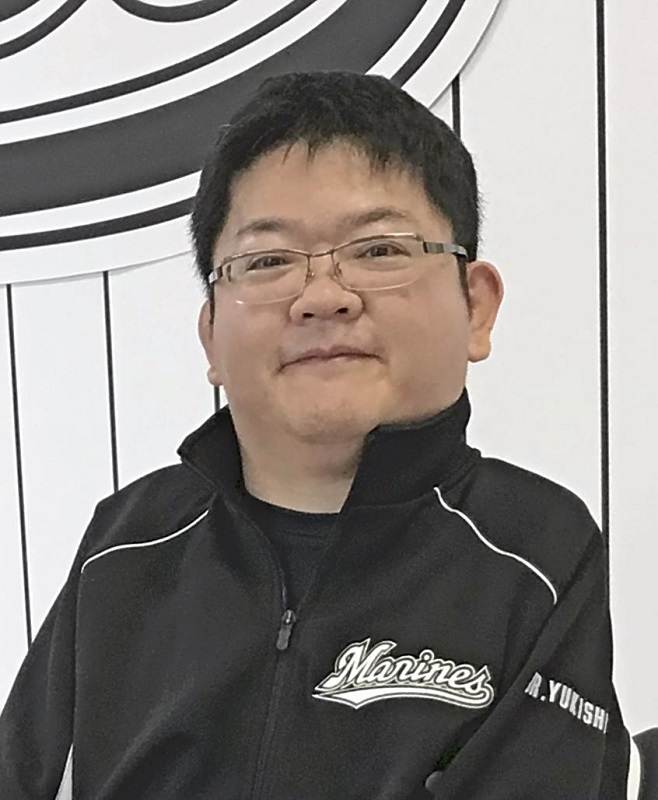
Takehiko Yukishita is seen in an accessible seating area and has an unobstructed view of the field at Fukuda Denshi Arena in October 2014.
14:19 JST, May 29, 2021

Takehiko Yukishita
A doctor who uses a wheelchair has been attracting a lot of attention as he has posted photos on Twitter of accessible seating areas at more than 20 sports stadiums and other facilities in Japan and the United States.
Takehiko Yukishita, a 48-year-old part-time lecturer of Juntendo University, aims to point out challenges from the perspective of someone who uses a wheelchair.
“I hope my posts will trigger a discussion and get people to think about how sports stadiums can be made more accessible for everyone,” he said.
Positive, negative reviews
“It’s great that there’s a clear line of sight,” Yukishita posted in September 2019 about an accessible seating area at the International Stadium Yokohama, which was one of the venues for the 2019 Rugby World Cup. Yukishita wrote that he had an unobstructed good view of the match.
However, he gave a negative review for another accessible seating area located in a different section of the same stadium. He realized that if someone were to stand in front of him, his view would be obstructed. The seating area was small, and it would be difficult for an accompanying person to sit next to him.
He criticized the area arrangement and posted: “An accompanying person has to sit behind the wheelchair user. It doesn’t meet the international standards.”
Considerations to make sports events more accessible to everyone were not given as much thought when the stadium was constructed in 1997, compared to today.
The Yokohama city government, which owns the stadium, is concerned about the scale of the task.
“We have been renovating restrooms and other facilities, but to increase the accessible areas, a number of general spectator seats will need to be removed,” a city official said. “It is difficult to immediately make changes.”
Life-changing injury
Yukishita began posting about accessible seating areas at sports facilities on Twitter around 2006. Since 2018, he has tweeted photos with messages about more than 20 sports facilities in Japan and the United States. The posts contain the hashtag meaning “accessible seating around the world” in Japanese.
In summer 1996, when Yukishita was in his sixth year at Juntendo University School of Medicine, he damaged his spine during a rugby match. As a result of the injury, he was paralyzed below the neck.
After being discharged from the hospital, he graduated from Juntendo University and enrolled in a university in the United States in 2002.
What he was most impressed by during his time in the U.S. was visiting Petco Park, which is the home of the San Diego Padres, in 2004.
There were accessible seating areas in every price bracket at the stadium. It was even possible to purchase premium field-level seats.
His favorite stadium in Japan is the Fukuda Denshi Arena, which is home of the J2 soccer team JEF United Ichihara Chiba.
The stadium, located in Chiba City, offers 110 accessible areas in seven different areas around the stadium so fans can watch the match from various angles. In addition, everyone is able to use the same route to reach the concession stands.
“I became a fan of JEF [United Ichihara Chiba] because I like the stadium,” Yukishita said.
Catalyst for change
Yukishita was an advisor for the Japan Sports Agency from 2016 to 2018. During his time, he proposed such ideas as organizing sports events that allowed people with disabilities to participate.
Even though many facilities have become more accessible in Japan ahead of the Tokyo Olympic and Paralympic Games, he thinks there are still many things that need to be improved.
For example, it took an hour for him to finally enter a stadium because the elevators were crowded and accessible parking was not available because it was being used by those without disabilities.
“Sports venues are places where people with and without disabilities can come together and enjoy [an event],” he said. “I want the Games to be the catalyst to bring about change, so people with disabilities will feel more comfortable going out more often.”
Yukishita encourages others to post information about accessible seating at other locations on his Twitter account.
More accessibility
The National Stadium in Tokyo, which is the main venue for the Tokyo Games, was designed in accordance with the accessibility standards stipulated by the organizing committee.
When the initial design was being considered in 2016, 14 organizations representing people with disabilities, as well as the elderly, held 21 meetings to point out improvements that could be made on about 90 issues, including accessible seating and restrooms.
Accessible seating areas are located all around the stadium so fans can watch the events from various angles. The areas allow people to charge their electric wheelchairs as well.
There are also five types of restrooms, including one type that allows a wheelchair user and an accompanying person to enter together.
"Society" POPULAR ARTICLE
-

M4.9 Earthquake Hits Tokyo, Neighboring Prefectures
-

Israeli Tourists Refused Accommodation at Hotel in Japan’s Nagano Pref., Prompting Protest by Israeli Embassy and Probe by Prefecture
-

M7.5 Earthquake Hits Northern Japan; Tsunami Waves Observed in Hokkaido, Aomori and Iwate Prefectures
-

Tsukiji Market Urges Tourists to Avoid Visiting in Year-End
-

M5.7 Earthquake Hits Japan’s Kumamoto Pref., Measuring Upper 5 Intensity, No Tsunami Expected
JN ACCESS RANKING
-

Tokyo Economic Security Forum to Hold Inaugural Meeting Amid Tense Global Environment
-

Keidanren Chairman Yoshinobu Tsutsui Visits Kashiwazaki-Kariwa Nuclear Power Plant; Inspects New Emergency Safety System
-

Imports of Rare Earths from China Facing Delays, May Be Caused by Deterioration of Japan-China Relations
-

University of Tokyo Professor Discusses Japanese Economic Security in Interview Ahead of Forum
-

Japan Pulls out of Vietnam Nuclear Project, Complicating Hanoi’s Power Plans






















